|
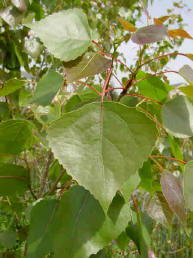 Fremont
Cottonwood Fremont
Cottonwood
Family Salicaceae (poplar)
Populus fremontii
Cottonwoods
are common trees found in local creeks within Alameda County. The
deciduous leaves are spade-shaped and become golden in fall. Wind
blowing through the trees sounds like running water. Male and
female flowers are borne on separate trees. The female tree has
cottony seeds that are dispersed by the wind that blooms March to
April. This tree is well known for its ability to grow quickly with
heights up to 35 meters. |
|
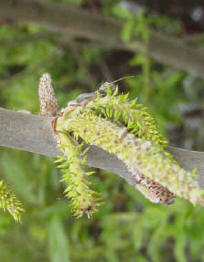 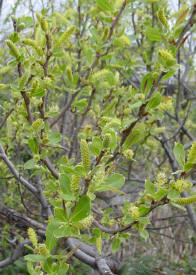 Arroyo
Willow Arroyo
Willow
Family Salicaceae (willow)
Salix lasiolepis
This native tree is
found in the wet soils along waterbeds in valleys, foothills and
mountains. It is also known as a white willow because it has light
colored bark and leaves with whitish lower surfaces. Some varieties
of willow bark were used by Native Americans to help reduce fever
and pain. The leaves are simple, about five inches long,
irregularly lancolate, and have entire rolled-under margins.
Arroyo Willows can reach as high as 10 meters. It produces yellow
flowers during the spring that grow on stems in bunches called
catkins. Willows are found growing in close proximity to the
water’s edge. Birds and other animals use these trees as nesting
and feeding places. |
|
  Red
Willow Red
Willow
Family Salicaceae (willow)
Salix laevigata
Red willow is a
medium-sized deciduous tree that always grows near water. The bark
of mature trees is dark and rough; young twigs may be red to
yellow-brown. The narrow leaves are green and shiny above, whitish
below, and usually widest below the middle. Male and female flowers
are borne on separate plants and appear soon after the leaves in
early spring. The tiny seed produced by the female catkin has a
cottony “fluff” and may be carried a great distance by the wind.
Because all willows root easily and grow quickly, they have
potential for holding soil on steep slopes. The flexible willow
shoots were used by the Ohlone Indians to make baskets and huts.
Willow bark contains salicin, which our bodies convert to salicylic
acid, the active pain-relieving ingredient in aspirin. |
|
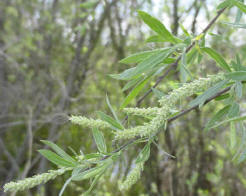 Sandbar
Willow Sandbar
Willow
Family Salicaceae (willow)
Salix exigua
New branches are grayish, and leaves have a
furry feeling. Leaves are very narrow compared to other willows in
the area. The trees grow 2-4 meters. The catkins are borne on
separate male and female trees about 1-4 cm in length bloom March
to May. |
  Yellow
Willow Yellow
Willow
Family Salicaceae (willow)
Salix lutea
A deciduous
shrub or rarely small tree. This willow is common in wet places
along streams in higher elevations. It takes the form of clustered
shrubs that grows to 2-5 meters high with yellowish to brownish
twigs. The male and female catkins are 4-8 cm long, appearing
before leaves, and are on separate trees. Seeds have a cottony down
which allow them to float for large distances. |
|
 Big-leaf Maple Big-leaf Maple
Family Aceraceae (maple)
Acer macrophyllum
Maples are easily
recognized by their large 3 to 5 palmately lobed deciduous leaves
that are arranged opposite to each other. The yellowish green
flowers appear after the leaves come out in spring. Flowers are
small, yellow, born in long racemes. The double winged fruits,
resembling helicopter blades, are called samaras. |
|
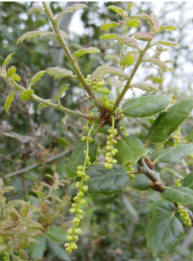 Coast Live Oak Coast Live Oak
Family Fagaceae (beech)
Quercus agrifolia
Coast live oak is an
evergreen tree which grows to 10-25 meters tall. It has a broad,
dense crown and spreading branches. The mature bark is gray and
shallowly furrowed. Leaves are oblong to oval, cupped with toothed
margins. Clusters of rusty hairs may be seen on the veins on the
back of the leaf. Acorns are narrowly conical and mature in one
year. Although coast live oak is often a component of riparian
California woodlands, it typically occurs on wooded and grassy
slopes. The Ohlone Indians leached acorns in water to remove the
bitter tannin before preparing breads, soups and porridges. |
|
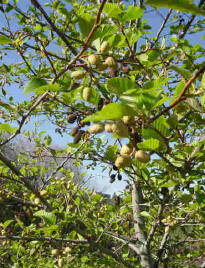 White Alder White Alder
Family Betulaceae (birch)
Alnus rhombifolia
Alders grow
at the immediate edge of perennial streams and are indicators of a
permanently high water table. White alder has deciduous, hairless,
flat leaves with toothed margins that are not rolled under. The
male and female flowers are borne in separate catkins on the same
tree. The woody female catkin resembles a small pine cone, and is
often gold-plated and used as jewelry. Young alder shoots were used
to make arrows. Dry, rotted alder wood was used along with willow
bark as a poultice on wounds. Alder roots produce a red dye and
were used to make caps and trinket baskets. Alders have
nitrogen-fixing bacteria on nodules on their roots, enabling them to
convert atmospheric nitrogen into nitrates and allowing them to grow
on poor soils. As alder leaves decompose, they enrich the soil and
make it more acidic, preparing the land for colonization by other
tree species. |
|
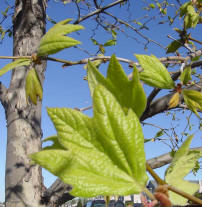 Western Sycamore Western Sycamore
Family Platanaceae (sycamore)
Platanus racemosa
Western
sycamore grows along creek beds. It is a large deciduous tree with
heavy twisted branches. Its characteristic peeling bark is smooth
and ashy-white with greenish-gray and tan patches. The broad leaves
are light green above and paler and rusty-hairy below. The fruits
are contained in small bristly “button-balls” borne in clusters on
the flower stalk. It is a food plant for western Tiger
Swallowtail. |
|
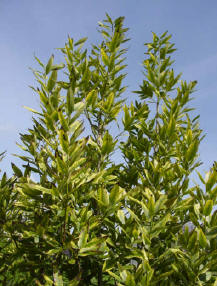 California Bay Laurel California Bay Laurel
Family Lauraceae (laurel)
Umbellularia californica
The evergreen
bay tree has simple leathery lance-shaped leaves. When crushed, the
pungent leaves smell like bay rum. Bay leaves are used to season
stews and sauces, and placed on pantry shelves to discourage insect
pests. Clusters of small fragrant yellow flowers appear in
December. The fruit resembles a small avocado and turns purplish
when mature. The heavy, fine-grained laurel wood and burls are used
to make plates, bowls, novelties and furniture and are often sold as
pepperwood or myrtle. |
  Northern Black Walnut Northern Black Walnut
Family Juglandaceae (walnut)
Juglans californica
var. hindsii
Leaves are
pinnately compound with 11 or more leaflets per leaf. During the
fall the shiny, resinous green leaves turn soft shades of yellow.
The black walnut contains a rich, oily nutmeat, but the thick shells
make it difficult to crack. They are seldom cultivates, but serves
as a rootstock onto which the English walnut is grafted. |
|
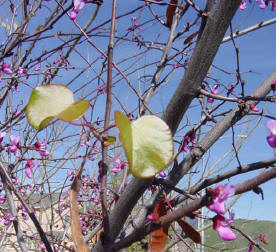 Western Redbud Western Redbud
Family Fabaceae (pea)
Cercis occidentalis
Flower is very
showy, light to dark pink in color, ½ inch long, appearing in
clusters in March to May before the leaves. Bark is dark in color,
smooth, later scaly with faint ridges. Fruits are flattened, dry,
brown, pea-like pods, 2 to 4 inches long. The flat, elliptical,
brown seeds ¼ inch long. Maturing in July to August. |
|
Blue
Elderberry
Family Caprifoliaceae (honeysuckle)
Sambucus mexicana
Blue
elderberry prefers canyon bottoms where water is available in
summer, but also grows on dry hillsides. Elderberries often start as
multi-trunked shrubs that mature into small trees. The deciduous
leaves are compound. The blue berries are eaten by wildlife and
were dried for later use by the Ohlones. Early Californians made
jam and wine from the berries. The creamy flat-topped flower
clusters can be dipped in pancake batter and fried. Elderberry
stems have a soft white central pith that can be removed, leaving a
hollow tube that serves as a flute, clapper, or gambling stick. |